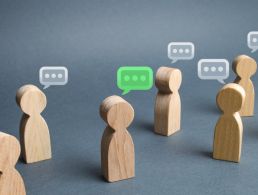Working from home during Covid-19 has forced many of us to say goodbye to shared lunch breaks. Here, Globant’s Mercedes MacPherson discusses how that might affect company culture.
One of the biggest differences many of us have had to adjust to since we started working from home is no longer spending lunch breaks with our colleagues. This has undoubtedly brought some benefits, such as potentially having access to your own kitchen or spending extra time with family or roommates.
However, a lack of physical lunch breaks with your work peers can ultimately be damaging to your company’s culture.
I spoke about this topic with Mercedes MacPherson, chief talent and diversity officer at software development company Globant. Communal breaks, she told me, are “an essential component of organisational culture”. They allow for informal communication, exchanging ideas, sharing perspectives, giving feedback and connecting on a personal level.
The drop in social interaction in recent months – or the pivot to new forms of connection – has been challenging, MacPherson said. “Connecting in an effective way has become crucial.”
Mercedes MacPherson. Image: Globant
Are Zoom calls the answer?
Some teams have introduced virtual coffee breaks or lunches, but how close are shared breaks on Zoom to the real thing? The problem here is that working from home means schedules aren’t always aligned the same way they might be in the office.
“So, while one colleague might be having their lunch break, another might be finishing a big project, attending to their kids or taking the dog for a walk,” MacPherson explained.
“Also, at home, our own family schedules begin to have an impact on each other. We need to arrange who is preparing lunch, attending a class or a meeting and who needs support and assistance while trying to fulfil our own responsibilities.”
‘Lunchtime is a crucial opportunity to integrate into a company’s culture by bonding with co-workers’
– MERCEDES MACPHERSON
Video calls have been a big help for keeping teams connected, she said, but it’s important that we recognise the challenges and limitations of this medium. “Over video, we’re hyper-focused on our few available visual cues, distracted by email notifications, children and pets, leading us to feel connected in some aspects of collaboration but disconnected in new ways.”
The link between lunch breaks and inclusion
Lunches are linked to better diversity and inclusion, according to MacPherson. “For many employees, lunchtime is the best part of the day. It allows them to turn away from the screen to stretch their legs, vent about work’s demands and, of course, grab something to eat,” she said.
“For those new to an organisation, lunchtime is a crucial opportunity to integrate into a company’s culture by bonding with co-workers.”
That integration, she explained, is a critical opportunity for staff to understand and appreciate the different roles and personal perspectives in the office and “to feel like a part of the bigger family at work”.
The dip in connectedness is something we need to address now as physical distancing rules will still likely make this difficult once businesses return to the office.
“While we can come together for socialising during a video lunch break, the experience is much different and diminished,” MacPherson said. “Even looking into the long term after we do return to the office, crowded cafeterias, communal snacks and buffet-style lunches will be off the table due to social distancing needs.
“The decline of lunch breaks while we work remotely can lead organisations to face more challenges in terms of connectedness and in building their connective tissue. That may even go further and have an impact on how productive we are.
“Globant recently found that difficulty communicating with colleagues and mental stress due to social isolation were leading negative impacts in work output due to working from home.”
What can you do?
Based on her own experiences, MacPherson shared some advice for companies hoping to boost employee interactions as Covid-19 restrictions continue.
“I think it is important not to let the Covid-19 scenario take over the agenda,” she said. “We needed to rearrange our priorities, putting our culture and employees at the centre. In our personal experience, this situation gave us a perfect opportunity to boost a series of diversity and inclusion initiatives reprioritising our existing goals. They had, in this context, more impact than ever before.”
The company recently launched Globant University, a platform to provide staff with on-the-job learning opportunities in the areas of tech, leadership, languages and Agile skills.
“I am convinced Covid-19’s challenges provide a unique opportunity for reinvention, unlearning and relearning new skills,” MacPherson added. “With this in mind, we launched Globant University during the epicentre of the pandemic.
“Considering many of our clients were impacted by the coronavirus, our employees were required to learn new abilities in order to find new opportunities for growth across projects and industries.”




